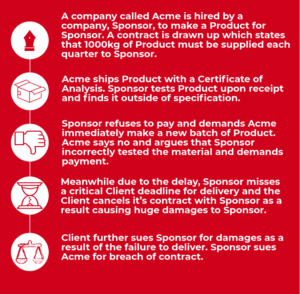Pharmaceutical Intellectual Property Law: How Much Do You Know?
Land O’ Lakes pharmaceutical science conferences are a great place to learn about cutting-edge research and current trends in the industry. However, the organizers believe that it is important to offer topics “outside the box”. On the first night of these conferences, the opening dinner features a speaker presenting a unique perspective on a topic in the pharmaceutical industry. The topics are related to hard science but often teach attendees about an aspect of the industry that they don’t deal with on a regular basis.
Eyal Barash, JD, from Barash Law gave a presentation titled ‘Outsourcing Pharmaceutical Manufacturing-Risks and Rewards’ at the June Land O’ Lakes Conference. Barash Law, based out of Lafayette, Indiana, specializes in intellectual property law focusing on pharmaceuticals and agriculture. Their area of expertise also includes solid form pharmaceutical patents, deals, intellectual property (IP) strategy and execution, and in-house counsel. Barash received his BS and MS in chemistry from Indiana University Bloomington and University of California, Berkeley before getting his law degree from Northwestern University.
Barash’s presentation explained how contracts and patents are integral to the success of outsourcing by pharmaceutical companies. There are many ways to reduce risk when outsourcing, but the presentation was focused on the two most common methods: confidential disclosure agreements (CDA)/non-disclosure agreements (NDA) and patents. Throughout the presentation, Barash gave real examples from his work to help the audience understand legal concepts associated with contracts and patents.
CDA/NDA: The Benefits and Pitfalls
One of the most commonly used contracts is a CDA/NDA. It is used to exchange information for a potentially useful business transaction. It keeps information confidential and only uses the information for the purpose of the agreement. There is no intellectual property (IP) transfer and the information is required to be returned at the end of the transaction. No services are exchanged at this point.
If it is decided that the company wants something more than information, then a different contract is signed for the exchange of services. Barash gave the following example to show why these contracts are so important:

Who is at fault?
This sounds like a pretty big mess but this is where contracts come in handy. There is usually a clause in the contract about what to do if a material is out of specification: use an independent expert, retest or refund. Regarding the Client, third-party indemnity applies. This is means Acme is liable for Client’s damages even though they may be far greater than the value of the contract between Acme and Sponsor.
Understanding Patents
Another important legal concept to understand in the pharmaceutical industry is a patent. A patent is not a right to use an invention, it is actually the right to exclude others from using an invention. For example:
“Company A owns a patent on antibiotic Compound and method of treating bacterial infection with compound. Company B discovers that that Compound also can be used to treat male pattern baldness. B files a patent on using Compound to treat male pattern baldness”
If scientists do not clearly understand intellectual property it can be easy for them to make mistakes that breach the patent qualifications. Such as in this case:
“YourCo wants to make a pitch to BigCo about an idea yet to be patented and a proper CDA is put in place. At the meeting YourCo presents its product and gives the PowerPoint presentation to BigCo. Someone at the meeting forwards the presentation to a Colleague. The Colleague uses it for a poster she is presenting next month. The poster publishes, violating the CDA. The product can no longer can be patented”
If the information on what is to be patented is made public, the patent rights are gone. There are many ways that this can happen so scientists need to be careful when sharing their research.
Eyal told many other stories of bungled patents that intrigued the crowd. His ability to mix it up with stories and jokes and to clearly explain legal jargon gave the audience an entertaining and informational presentation. Everyone left with a more in-depth understanding and great appreciation for pharmaceutical intellectual property law. For legal advice or answers to other questions check out Barash Law’s website.
Additional resources:
US Patent and Trademark Office
